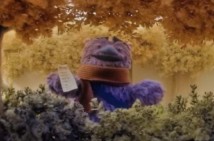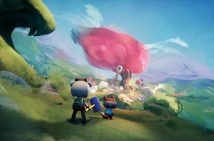Submarine Channel

Inspirations Behind VR Doc The Ark
Top5's
Inspirations Behind VR Doc The Ark
Integrating new technologies into storytelling is the name of the game. And Submarine Channel alums Kel O’Neill and Eline Jongsma, are doing just that with their new VR documentary, The Ark. They’ve used virtual reality technology to put viewers face to face with the world’s most endangered species: the Northern white rhinoceros.
Inspired by artists and driven by passion, Jongsma & O’Neill have managed to create a unique, inspiring, and most importantly honest piece of innovative filmmaking that tells an important global story of culture, conservation, and survival.
The Ark premiered April 14th, 2016, at the Tribeca Film Festival: Storyscapes – a program that hosts a myriad of innovative and forward thinking projects.
The Ark is not your typical conservation documentary; with some clever stitching of footage and the hauntingly smooth tone setting music of Matthew Dougherty, American stem cell researchers and Kenyan park rangers are literally juxtaposed on the 360 degree stage offered by the VR headset. This exposes the tensions and connections between these two seemingly unrelated places as they fight to save a species that is quickly disappearing. The viewer can almost choose their own adventure – look straight ahead and see the sunrise feeding of Sudan, the last remaining male of the species, on the Ol Pejeta Conservancy in Kenya. Turn around and you’ll find yourself standing in a room at the Scripps genetic research lab in San Diego, CA, watching scientists pull cylindrical vials of frozen genetic material from storage in an almost Jurassic Park style attempt to beat extinction. Watch the 360 trailer of The Ark here, or visit the Kickstarter campaign.
Working in a new medium is brave, as it welcomes a host of technological and creative challenges. Innovation stems from inspiration, and Jongsma & O’Neill (who are now working on EXIT) have had many creative influences over the course of their first foray in the world of virtual reality. Guest blogger Claudia Dibbs touched base with them recently to discuss the Top 5 inspirations behind The Ark:
1. Leviathan
Lucien Castaing-Taylor and Véréna Paravel originally set out to create a documentary about New Bedford, a historical whaling town in New England and the setting for Herman Melville’s 1851 novel Moby Dick. But the city’s contemporary status as a major fishing port drew the filmmakers in, and their film soon transformed into a raw, personal, and sometimes bloody expose of the commercial fishing industry. Shot entirely on GoPro cameras that are often strapped to the filmmakers and crew members, it’s no wonder that this first-person perspective has inspired artists who want to work with VR technology. Distinctly lacking narration or dialogue, Leviathan actively places the viewer inside one of the most dangerous jobs in the United States while stretching the limits of what it means to be a documentary–and a nature documentary in particular. As O’Neill states, “Most nature documentaries fetishize the idea of unspoiled nature, and create the illusion that all wildlife exists in some distinct, human-free universe. Leviathan is a ‘post-nature’ documentary; the filmmakers present a vision of the world in which humanity dominates, and animals are just a commodity to be harvested.”
2. All That’s Solid Melts into Air
In this video installation piece by Mark Boulos, the viewer stands between two large screens that each offers a perspective of the oil crisis on opposite sides of the world. On one side is the Chicago Mercantile Exchange on the first day of the credit crisis in 2008. The other tells the story of Nigerian militants fighting against the exploitation of the people living in one of the world’s largest oil fields. Both are struggling to control oil, but in two vastly different ways. You can watch the remaining bastions of colonialism in Nigeria breaking down an already impoverished community as they battle for natural resources. Turn around, and suddenly the human element of this story dissolves into pure financial capital. The installation uses the space between the screens to signify the evaporation of a physical resource into intangible wealth. Says Jongsma, “I love documentary work that uses space as an element in the story. You’re not just using the frame that a camera provides but you’re pushing beyond that.”
3. Brent Stirton and Ami Vitale: Wildlife Photographers
Any reader of National Geographic would be familiar with the work of these two wildlife photographers. Both have used the endangered Northern white rhinos and their bodyguards as their subjects. Stirton has also completed a photo series, “Rhino Wars,” that captures the brutality of the African ivory trade. As O’Neill says, “Love that Bret Stirton. He really can shoot.” And Jongsma? “Love that Ami Vitale. She really can shoot.”
4. Clouds Over Sidra
This collaboration between filmmakers Gabo Arora, Chris Milk and the United Nations resulted in a VR documentary that was one of the first of its kind. The film follows 12 year old Sidra in her life as a Syrian refugee at the Za’atari camp in Jordan. According to the filmmakers, the impetus behind this collaboration was to offer a unique perspective of some of the world’s most vulnerable inhabitants. VR can have a more profound impact on the viewer because it allows the viewer to experience total immersion in an environment—and can illicit empathy and solidarity for a group of people that is often overlooked. For O’Neill and Jongsma, this technology made a real impression. “Clouds over Sidra was the first documentary VR piece that I watched,” says Jongsma. “It removed my body from the experience of watching a documentary. When you watch, you don’t feel grounded. You feel elevated, hyper aware and it’s almost like living in a vivid dream. I really gravitated towards that experience.”
5. Pieter Hugo: Photographer
This South African photographer has a unique voice and perspective of modern African life. With much of his work capturing marginalized African communities, his point of view is filtered through a very distinct style of center framing his subjects. How can this influence a VR project like The Ark? What does center framing mean when you’re working in a medium that has no frame? “Pieter Hugo shows us modern life in Africa, not the Western view of the continent,” Jongsma adds. “In addition, some of his work deals with the relationship between humans and animals. And his work is just stunning. There is no frame in VR but as a creator you are still directing the viewer. You are still composing shots.”
Claudia Dibbs lives in Los Angeles and was formerly the digital media fellow at Taproot Foundation. She worked with Jongsma + O’Neill as the associate producer for their virtual reality documentary The Ark.








